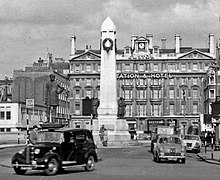Statue of Robert Stephenson
 From Wikipedia - Reading time: 11 min
From Wikipedia - Reading time: 11 min
| Statue of Robert Stephenson | |
|---|---|
 | |
| Artist | Carlo Marochetti |
| Medium | Bronze |
| Subject | Robert Stephenson |
| Location | Euston station, London |
Listed Building – Grade II | |
| Official name | Statue of Robert Stephenson in Euston Station Forecourt |
| Designated | 14 May 1974 |
| Reference no. | 1342041 |
A bronze statue of Robert Stephenson by Carlo Marochetti usually stands on a red granite plinth in the forecourt of Euston railway station in London, England. Erected in 1871, it is one of few surviving elements of the original station after it was redeveloped in the 1960s, and it became a Grade II listed building in 1974. It was temporarily removed in 2020 to allow the station to be remodelled to accommodate the new High Speed 2 (HS2) railway line.
Description
[edit]The 2.7 m (8 ft 10 in) high bronze statue portrays Stephenson standing casually, bareheaded, with his right leg slightly forward, in contemporary Victorian dress of frock coat and trousers. He has a partially unrolled document in his right hand, and the left hand rests on his hip. The red Aberdeen granite plinth bears the inscription ROBERT STEPHENSON/ BORN/ OCTOBER 16TH 1803/ DIED OCTOBER 12TH 1859.[1]
Background
[edit]A memorial committee of the Institute of Civil Engineers commissioned the statue after Stephenson's death on 12 October 1859. It was completed before Marochetti's death in 1867, but remained in storage while protracted discussions continued about an appropriate site to erect it and other statues.[2]
The Institute of Civil Engineers had also commissioned Marochetti to make a similar statue of Stephenson's rival engineer Isambard Kingdom Brunel, after Brunel's death a few weeks before Stephenson on 14 September 1859,[3] and then a third statue for the railway engineer Joseph Locke who died a year later, on 18 September 1860. The intention was to erect the three statues together in a prominent position in Parliament Square, then known as the churchyard of St Margaret's, Westminster, near the statue of George Canning beside the offices of the Institute of Civil Engineers at One Great George Street. After initially granting permission, the Office of Works decided against in 1868, reserving the space for statues of politicians.[4]
Ultimately the three statues were erected separately. Marochetti's statue of Joseph Locke was installed in Locke Park, Barnsley, in 1866.[5] The statue and its enclosure were listed at Grade II in 1986.[6] A copy is displayed in Barentin, France, where Locke designed a railway viaduct. The statue of Brunel was erected in 1874 on the Victoria Embankment, at the west end of Temple Place, on a Portland stone pedestal with novel flanking screen walls and benches by the architect Richard Norman Shaw. It became a grade II listed building in 1958.[7]
Installation at Euston station
[edit]
The Institute of Civil Engineers presented the statue of Stephenson to the London and North Western Railway, which from 1846 brought together the London and Birmingham Railway, the Grand Junction Railway and the Liverpool and Manchester Railway, all of which had engaged Stephenson or his father George Stephenson. Euston was the railway's London terminus, and an 1852 marble statue of George Stephenson by Edward Hodges Baily was already displayed within the main hall of the station (it is now at the National Railway Museum, York). Similar to Marochetti's statue of Robert Stephenson, Baily's statue of his father also shows the subject standing in contemporary dress, holding an partially unrolled document the right hand.
The statue of Robert Stephenson was erected on a red granite pedestal outside Euston railway station in 1871, originally sited between the entrance lodges to the station precincts. It was moved to the east side of the station when it was redeveloped in the 1960s, and moved again in 2008 when further redevelopment was proposed to stand to the west side of the station forecourt. The statue is one of few surviving elements of the original station after it was redeveloped in the 1960s, and it was listed at Grade II in 1974.[8][9]
The statue was removed in 2020 to allow further redevelopment works, remodelling the station for the new HS2 railway line to Birmingham.[10]
-
Photograph of Robert Stephenson in 1856
-
Robert Stephenson's statue in its original position in 1962 after the arch had been removed
-
Robert Stephenson's statue in its previous position outside Euston station, 2007
-
Marble statue of George Stephenson in the hall of the old Euston Station, 1914
-
Statue of George Stephenson, now at the National Railway Museum, York, pictured in 2008
-
Statue of Brunel, 2004
-
Brunel statue in 2014
-
Statue of Joseph Locke, in Locke Park, Barnsley, in 2007
References
[edit]- ^ Statue of Robert Stephenson in Euston Station Forecourt, National Heritage List for England, Historic England
- ^ Baron (Pietro) Carlo Giovanni Battista Marochetti, Mapping the Practice and Profession of Sculpture in Britain and Ireland 1851–1951, University of Glasgow
- ^ Isambard Kingdom Brunel, Baron Marochetti, 1864, The Victorian Web
- ^ Isambard Kingdom Brunel, from Philip Ward-Jackson's Marochetti catalogue, FineArtFacts
- ^ Joseph Locke, from Philip Ward-Jackson's Marochetti catalogue, FineArtFacts
- ^ Statue of Joseph Locke and enclosure in Locke Park, National Heritage List for England, Historic England
- ^ Statue of I K Brunel, National Heritage List for England, Historic England
- ^ Richard Norman Shaw, Andrew Saint, Yale University Press for the Paul Mellon Centre for Studies in British Art, 2010, ISBN 0300155263, p.48
- ^ Robert Stephenson, from Philip Ward-Jackson's Marochetti catalogue, FineArtFacts
- ^ Safe storage for Stephenson statue during Euston’s HS2 transformation, Network Rail, 12 October 2020
External links
[edit]- Statue of Robert Stephenson, engineering-timelines.com
- Statue: Robert Stephenson statue, londonremembers.com
 KSF
KSF






